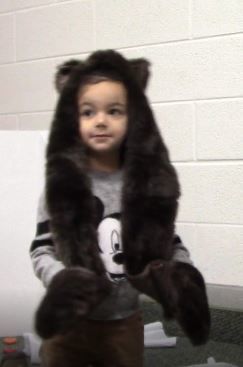
Play
Learning From Passive Versus Active Pretense
Children learn equally well whether they are passive watchers or active players.
Posted October 8, 2019
This post was co-written by Dr. Thalia R. Goldstein (posted on her blog here), and Brittany Thompson. The post describes an academic paper recently published in Child Development.
One possible contribution of pretend play to children’s development is in the area of learning, where children use pretend play to learn about the real world. Research on children’s learning from fictional contexts shows that children learn from engaging with storybooks (Walker, Gopnik, & Ganea, 2015), videos (Mares & Sivakumar, 2014), and puppet shows (Sutherland & Friedman, 2012).
But research on learning in these contexts tends to be presentational in nature—children are passive watchers of the pretense or fiction rather than active players. Children’s natural play is active and physical. In this study, we sought to replicate an existing study about children’s learning from pretense and extend it to two additional active, engaged, and embodied pretend play conditions as well.

A Replication and Extension: Passively-Presented and Actively-Embodied Pretend Play
The study we replicated was Sutherland & Friedman’s (2012) study in which children were presented a puppet show about a novel animal (a “nerp”) and asked questions about “nerps” afterward. The goal was to see if children generalized information learned via the presentational pretense about a specific nerp to the broader category of nerps. They found that children did, in fact, learn from watching this puppet show.
In the present study, we exactly replicated the protocol of Sutherland & Friedman (2012), with protocols and descriptions of materials helpfully and graciously provided by the authors of that paper, and extended that protocol to new conditions. We had four conditions, to which children were randomly assigned:
1. Replication of previous watching condition: Children watched a puppet show following the exact protocol of Sutherland and Friedman (2012). Through the puppet show, research assistants conveyed the nerp’s likes, dislikes, and preferences regarding four different items.
Then, children were shown a picture of a real slow loris and told: “Here is a nerp, and I am going to ask you some questions about nerps.” Children were asked questions about nerps’ preferences for the four items, with two answer options per question (one being the correct answer based on the puppet show, and one being a distractor item).
2. Replication of previous control condition: Children watched the same puppet show as the first replication condition, but were asked questions that were not related to the facts learned through the puppet show. This served as a control condition, where children should choose the “correct” answer at chance levels.
3. Partially-embodied puppet condition: Children engaged in interactive puppet play following a similar script and conveying information about the nerp’s likes, dislikes, and preferences for the same four items that were used in the replication conditions.
The research assistant and child each had a “nerp” puppet, and the research assistant guided the child through puppet play using the same items as were used in the presentational puppet show in the “replication of previous watching condition.” Then, children were shown the picture of the real slow loris and answered the same questions as described in the replication of the previous watching condition.
4. Fully-embodied costume condition: Children engaged in interactive costume play following the exact same script as the puppet play, and conveying the same information about the nerp as described for all other conditions.
The research assistant and the child each wore a “nerp” costume, and the research assistant guided the child through costume play using life-sized versions of the items that were used in all three of the puppet conditions. Then, children were shown the picture of the real slow loris and answered the same questions as described in the replication of the previous watching condition.
There were 144 participants between the ages of 24 and 79 months. Participants were categorized into three age groups for analyses: 3-year-olds (2-year-olds were included here; N = 42), 4-year-olds (N = 61), and 5-year-olds (6-year-olds were included here; N = 41). There were 38 children in the replication of the previous watching condition, 37 in the replication of the previous control condition, 34 in the partially-embodied puppet condition, and 35 in the fully-embodied costumes condition.
An important contribution of this study was the inclusion of a two-week follow-up, where children were asked the same questions and were shown the same pictures corresponding to each question as they were asked when they first participated. The two-week follow-up included a smaller sample of 96 children (30 3-year-olds, 50 4-year-olds, 16 5-year-olds) due to the availability of participants. But, there were no significant differences between follow-up participants and non-participants on initial scores, F(1,143) = 1.35, p = .247.
First, we analyzed children’s performance immediately after engaging in or watching the pretense. Three-year-olds chose the correct response on significantly fewer questions than 4- and 5-year-olds, who did not differ from each other. Across all three age groups, children performed significantly worse in the control condition than the three other conditions (replication watching, puppet, or costume), and there was no difference between the three non-control conditions.
Then, we analyzed the children’s performance at the two-week follow-up. Three-year-olds again scored significantly worse than both 4- and 5-year-olds. In fact, three-year-olds were no different than chance at Time 2, meaning that they did not seem to be recalling anything from the pretend play, whether it was presented to them, or they actively engaged in it, two weeks later. Children across all three age groups again performed significantly worse on the control condition compared to the other three conditions.
Key Takeaways
1. Children learn equally well from passively-presented and actively-embodied pretense, at least for learning simple facts.
2. Older preschoolers (4- and 5-year-olds) retain some information regarding simple facts over a two-week time period.
3. Three-year-olds struggled to learn from pretense, compared to 4- and 5-year-olds. Possible reasons for this include that embodying a role may be more difficult or that multi-modal sensory integration is not yet developed in these young preschoolers.
4. The results of Sutherland & Friedman (2012) were replicated, almost exactly, in this larger sample of preschoolers, strengthening the claim that children can and do learn from pretense.
Some research finds that physical embodiment and gesture improves learning in various academic areas (e.g., math—Mavilidi et al., 2018; science—Mavilidi et al., 2017), which is not what we found here. One possibility is that the gestures used in pretense are more representational in nature, while those used in previous research on the role of gesture in learning were more directly related to the material being learned.
Another possibility is that the use of props across conditions resulted in a similar performance, where using more presentational (e.g., videos, storybooks) rather than prop-based pretense may yield different results. Yet another possibility is that the material being learned was too simple, and the questions presented were too easy to elucidate differences by the condition. Children were at near-ceiling levels across conditions (except for the control condition).
More complex material and more difficult questions may illuminate differences amongst these various types of pretense. Further research on this question is necessary to understand the lack of differences by condition found here—and is something our lab is currently working on.
References
Mares, M.-L., & Sivakumar, G. (2014). “Vámonos means go, but that’s made up for the show”: Reality confusions and learning from educational TV. Developmental Psychology, 50, 2498-2511. doi:10.1037/a0038041
Mavilidi, M.-F., Okely, A., Chandler, P., Louise Domazet, S., & Paas, F. (2018). Immediate and delayed effects of integrating physical activity into preschool children’s learning of numeracy skills. Journal of Experimental Child Psychology, 166, 502-519. doi:10.1016/j.jecp.2017.09.009
Mavilidi, M. F., Okely, A. D., Chandler, P., & Paas, F. (2017). Effects of integrating physical activities into a science lesson on preschool children’s learning and enjoyment. Applied Cognitive Psychology, 31, 281–290. doi:10.1002/acp.3325
Sutherland, S. L. & Friedman, O. (2012). Preschooler acquire general knowledge by sharing in pretense. Child Development, 83, 1064-1071. doi:10.1111/j.1467-8624.2012.01748.x
Walker, C. M., Gopnik, A., & Ganea, P. A. (2015). Learning to learn from stories: Children’s developing sensitivity to the causal structure of fictional worlds. Child Development, 86, 310–318.



